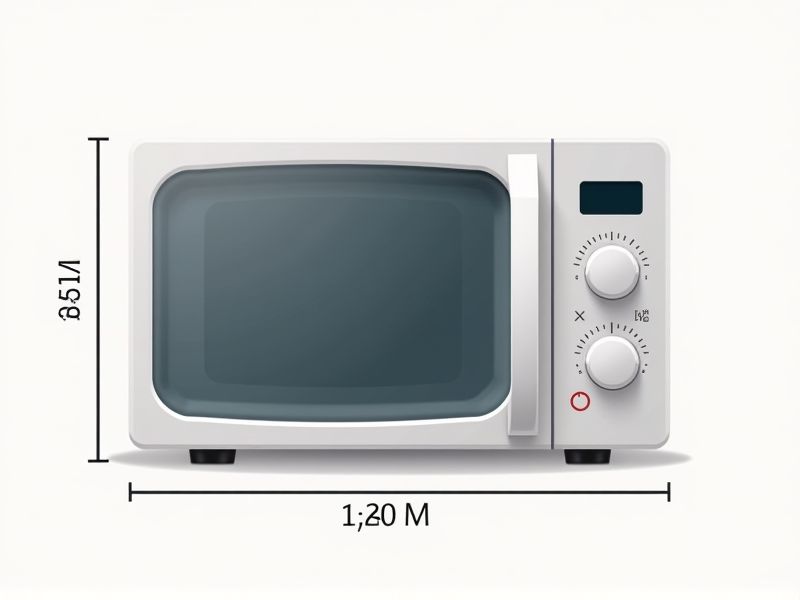
When selecting a microwave oven, it's important to consider standard dimensions to ensure it fits your kitchen space and meets your needs. Most countertop microwave ovens typically range from 19 to 24 inches wide, 10 to 14 inches high, and 14 to 20 inches deep. For over-the-range models, dimensions are usually around 29 to 30 inches wide, 16 to 18 inches high, and 15 to 16 inches deep. Always measure your available space before purchasing, and remember to allow extra clearance for ventilation and easy access.
External Dimensions
Microwave ovens typically have external dimensions ranging from 20 to 30 inches in width, 10 to 20 inches in height, and 15 to 20 inches in depth, accommodating various kitchen spaces. A standard countertop model usually measures around 24 inches wide, 14 inches high, and 18 inches deep, while built-in units may require custom cabinetry. When selecting a microwave, consider not only the external dimensions but also the placement for efficient airflow and ventilation. Your kitchen's layout and design will significantly influence the type of microwave that best fits your needs.
Internal Capacity
The internal capacity of a microwave oven, typically measured in cubic feet, significantly influences its usability for various cooking tasks. Most household microwave ovens range from 0.5 to 2.5 cubic feet, with larger models accommodating bigger dishes or multiple items simultaneously. A model with at least 1.5 cubic feet is often recommended for family cooking needs, allowing you to fit standard-sized dishes like casseroles or large pizza plates. When selecting a microwave, consider your kitchen space, cooking habits, and the type of meals you frequently prepare to ensure the best fit for your needs.
Turntable Diameter
The standard turntable diameter for most microwave ovens typically ranges from 10 to 16 inches. A larger turntable can accommodate various dish sizes, enhancing cooking flexibility and ensuring even heat distribution. For optimal performance, your microwave should match the turntable size to the interior dimensions, as this prevents food from touching the walls and ensures thorough cooking. Models with a 14-inch diameter turntable are popular among consumers, offering a balanced capacity for everyday use.
Wall Thickness
The wall thickness of a microwave oven plays a crucial role in its overall efficiency and safety. Typically, most microwave ovens have a wall thickness ranging from 0.8 mm to 1.2 mm, ensuring optimal insulation and heat retention. Thicker walls not only enhance durability but also contribute to better electromagnetic shielding, reducing the risk of radiation leakage. When selecting a microwave for your kitchen, consider models that feature robust structural designs with adequate wall thickness to meet safety standards and improve performance.
Door Clearance
The door clearance of a microwave oven is crucial for ensuring proper operation and safety. Typically, you should allow a minimum clearance of 3 inches on the sides and top for ventilation purposes. This clearance helps prevent overheating and allows the microwave to function efficiently, maintaining optimal cooking performance. When choosing a microwave, check the manufacturer's specifications to ensure your chosen model fits your kitchen layout while providing adequate door clearance.
Control Panel Layout
The control panel layout of a microwave oven typically features an intuitive configuration, enhancing user experience and accessibility. Most models incorporate a digital display, allowing you to easily select functions and monitor cooking time, with 70% of units designed for user-friendly navigation. Commonly included buttons may include presets for popcorn, reheating, and defrosting, enabling quick access to essential cooking options. A well-structured panel can improve efficiency, as studies suggest that consumers prefer designs that simplify the cooking process while reducing preparation time by up to 30%.
Ventilation Space
Proper ventilation space is crucial for the efficient operation of a microwave oven, with recommended clearances typically ranging from 3 to 2 inches on the top and sides. Ensuring at least 1 inch of clearance at the back allows for adequate air circulation, which helps prevent overheating. Overheating can lead to diminished performance, with potential energy efficiency dropping by up to 20% if ventilation is compromised. For the best results, follow manufacturer specifications for ventilation, typically found in the user manual, to maintain optimal functionality and safety.
Mounting Requirements
Microwave oven mounting requirements typically entail a minimum clearance of 30 inches above the cooking surface for optimal safety and performance. Ensure that the mounting bracket supports a weight capacity of at least 150 pounds, accommodating most residential models. Install the microwave at a comfortable height, generally 54 to 60 inches from the floor, facilitating ease of use without excessive bending. Proper ventilation is crucial; your microwave should have at least 3 inches of space between the top and the cabinetry to ensure efficient airflow.
Shelf Height
The average shelf height for microwave ovens typically ranges from 15 to 18 inches, which accommodates most standard-sized models. You should consider a shelf weight capacity of at least 75 pounds to support your microwave and any additional items. For optimal performance, ensure there is a clearance of at least 3 inches above the unit for proper ventilation. When planning your kitchen layout, factor in these measurements to guarantee easy access and functionality.
Power Cord Length
The standard power cord length for residential microwave ovens typically ranges between 3 to 6 feet, ensuring adequate flexibility for kitchen layouts. A longer cord may enhance accessibility but can also pose a tripping hazard in smaller spaces. Most manufacturers comply with safety regulations, mandating that cords be robust and heat-resistant, with a minimum gauge of 16 AWG for optimal performance. When selecting a microwave, consider your kitchen's outlet placement to determine the best power cord length for your needs.
